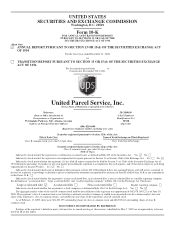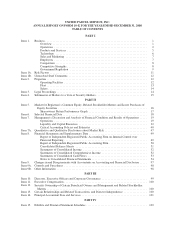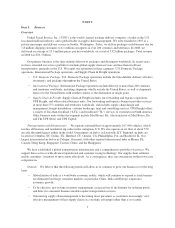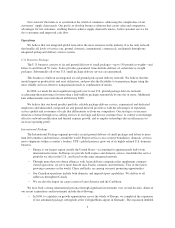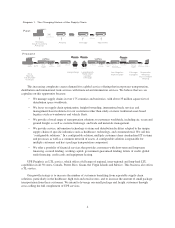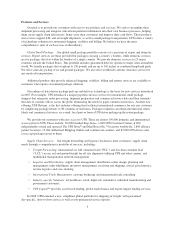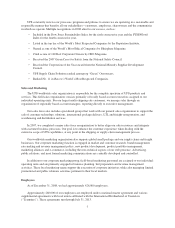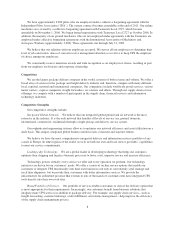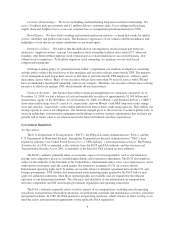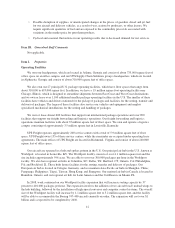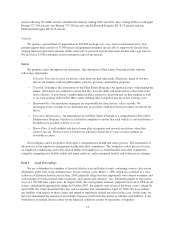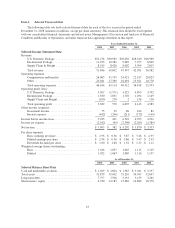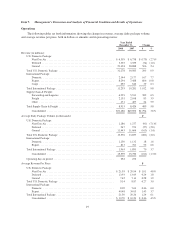UPS 2008 Annual Report Download - page 20
Download and view the complete annual report
Please find page 20 of the 2008 UPS annual report below. You can navigate through the pages in the report by either clicking on the pages listed below, or by using the keyword search tool below to find specific information within the annual report.Customer Relationships. We focus on building and maintaining long-term customer relationships. We
serve 1.8 million pick-up customers and 6.1 million delivery customers daily. Cross-selling small package,
supply chain and freight services across our customer base is an important growth mechanism for UPS.
Brand Equity. We have built a leading and trusted brand in our industry—a brand that stands for quality
service, reliability and product innovation. The distinctive appearance of our vehicles and the friendliness and
helpfulness of our drivers are major contributors to our brand equity.
Distinctive Culture. We believe that the dedication of our employees results in large part from our
distinctive “employee-owner” concept. Our employee stock ownership tradition dates from 1927, when our
founders, who believed that employee stock ownership was a vital foundation for successful business, first
offered stock to employees. To facilitate employee stock ownership, we maintain several stock-based
compensation programs.
Our long-standing policy of “promotion from within” complements our tradition of employee ownership,
and this policy reduces the need for us to hire managers and executive officers from outside UPS. The majority
of our management team began their careers as full-time or part-time hourly UPS employees, and have spent
their entire careers with us. Many of our executive officers have more than 30 years of service with UPS and
have accumulated a meaningful ownership stake in our company. Therefore, our executive officers have a strong
incentive to effectively manage UPS, which benefits all our shareowners.
Financial Strength. Our balance sheet reflects financial strength that few companies can match. As of
December 31, 2008, we had a balance of cash and marketable securities of approximately $1.049 billion and
shareowners’ equity of $6.780 billion. As of December 31, 2008, our Moody’s and Standard & Poor’s (“S&P”)
short-term credit ratings were P-1 and A-1+, respectively, and our Moody’s and S&P long-term credit ratings
were Aa2 and AA-, respectively, with a stable outlook from both of these credit rating agencies. This reflects our
strong capacity to service our obligations. Our financial strength gives us the resources to achieve global scale; to
invest in technology, transportation equipment and buildings; to pursue strategic opportunities that facilitate our
growth; and to return value to our shareowners in the form of dividends and share repurchases.
Government Regulation
Air Operations
The U.S. Department of Transportation (“DOT”), the Federal Aviation Administration (“FAA”), and the
U.S. Department of Homeland Security, through the Transportation Security Administration (“TSA”), have
regulatory authority over United Parcel Service Co.’s (“UPS Airlines’”) air transportation services. The Federal
Aviation Act of 1958, as amended, is the statutory basis for DOT and FAA authority and the Aviation and
Transportation Security Act of 2001, as amended, is the basis for TSA aviation security authority.
The DOT’s authority primarily relates to economic aspects of air transportation, such as discriminatory
pricing, non-competitive practices, interlocking relations and cooperative agreements. The DOT also regulates,
subject to the authority of the President of the United States, international routes, fares, rates and practices, and is
authorized to investigate and take action against discriminatory treatment of U.S. air carriers abroad.
International operating rights for U.S. airlines are usually subject to bilateral agreement between the U.S. and
foreign governments. UPS Airlines has international route operating rights granted by the DOT and we may
apply for additional authorities when those operating rights are available and are required for the efficient
operation of our international network. The efficiency and flexibility of our international air transportation
network is dependent on DOT and foreign government regulations and operating restrictions.
The FAA’s authority primarily relates to safety aspects of air transportation, including aircraft operating
procedures, transportation of hazardous materials, record keeping standards and maintenance activities, personnel
and ground facilities. In 1988, the FAA granted us an operating certificate, which remains in effect so long as we
meet the safety and operational requirements of the applicable FAA regulations.
9


